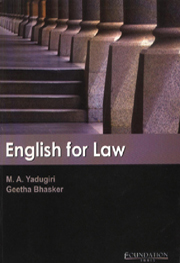Book contents
- Frontmatter
- Preface
- Contents
- A Note to the Student
- Notes to the Teacher
- 1 Nature of Law
- 2 Crimes and Civil Wrongs
- 3 Command of Language in the Profession of the Law
- 4 Plain Language and the Law
- 5 The Indian Constitution
- 6 The Impact of Technology on the Practice of Law
- 7 The International Court of Justice
- 8 Application of Precedents
- 9 Statutory Interpretation
- 10 Legal Reasoning
- 11 Plaints and Writs
- 12 Judgment
- 13 Of Defamation
- 14 Consumer Protection (Amendment) Act, 1993
- 15 The Information Technology Act, 2000
- 16 Universal Declaration of Human Rights
- Answer Key
5 - The Indian Constitution
Published online by Cambridge University Press: 26 October 2011
- Frontmatter
- Preface
- Contents
- A Note to the Student
- Notes to the Teacher
- 1 Nature of Law
- 2 Crimes and Civil Wrongs
- 3 Command of Language in the Profession of the Law
- 4 Plain Language and the Law
- 5 The Indian Constitution
- 6 The Impact of Technology on the Practice of Law
- 7 The International Court of Justice
- 8 Application of Precedents
- 9 Statutory Interpretation
- 10 Legal Reasoning
- 11 Plaints and Writs
- 12 Judgment
- 13 Of Defamation
- 14 Consumer Protection (Amendment) Act, 1993
- 15 The Information Technology Act, 2000
- 16 Universal Declaration of Human Rights
- Answer Key
Summary
The structure of the Indian Constitution is said to be characteristically British. ‘The machinery of government is essentially British and the whole collection of British constitutional conventions has apparently been incorporated as conventions.’
(Sir Ivor Jennings, Some Characteristics of the Indian Constitution, p. 2)
The builders of the Indian Constitution not only drew largely from the collection of British ideas and institutions which was India's heritage from British rule, but they also took care to maintain a continuity with the governmental system which had grown up under the British. They believed not in severing their links with the past but rather in treasuring all that had been useful and to which they had been accustomed. The structure which emerged was therefore not only basically British in its framework but took the fonri of an alteration and extension of what had previously existed …
The year 1947 witnessed the fruition of the Indian struggle for freedom; a bloodless revolution which brought about the transfer of power from British to Indian hands. The manner in which this transfer was effected was in some respects unique. The British Parliament which had governed the country for about a century abdicated; and by the very statute by which it abdicated – the Indian Independence Act – it created a new dominion, the Dominion of India.
- Type
- Chapter
- Information
- English for Law , pp. 133 - 169Publisher: Foundation BooksPrint publication year: 2005



